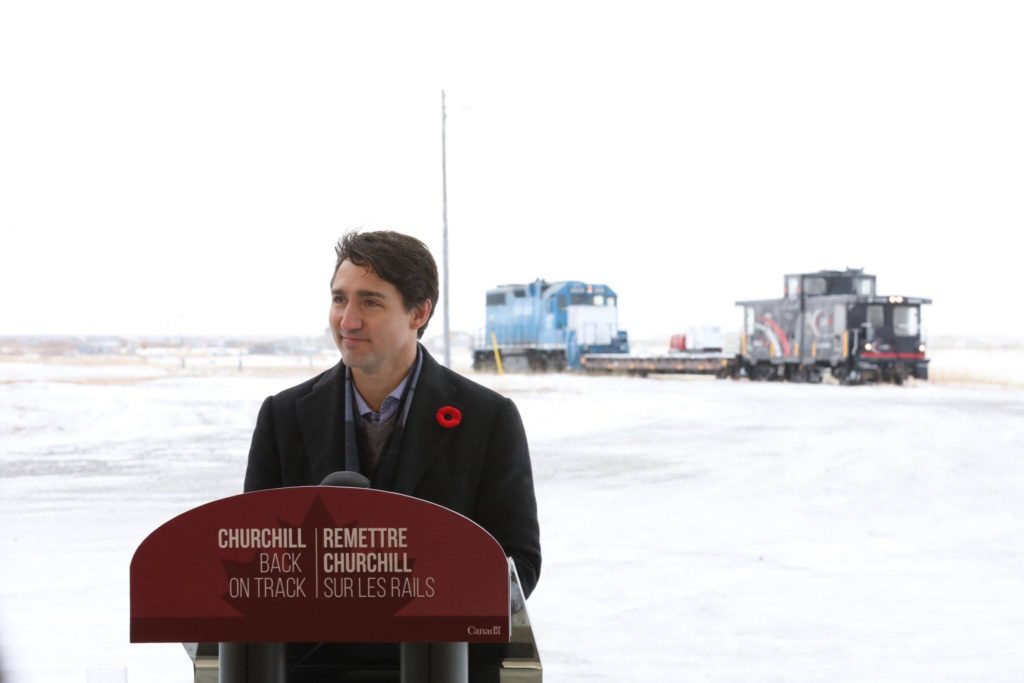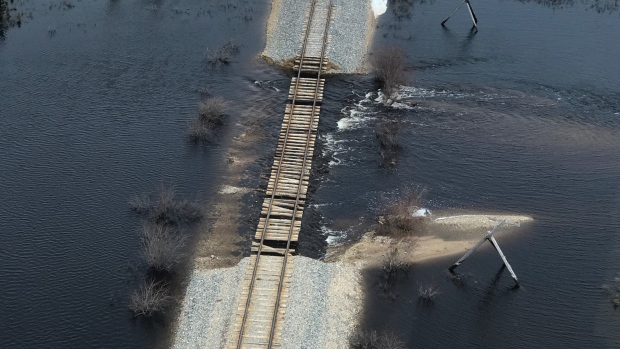by Steve Selden | Nov 2, 2018 | Tour News
The people of Churchill have not heard the whistle of a train for 17 months…until Wednesday. The first train to reach Churchill in nearly a year and a half pulled into the station to the joyous yells and screams of townspeople running to greet the engines. This first train was just a small one with a couple of engines, flat car, and caboose. A test of tracks for longer passenger and cargo trains set to come by the end of November.

The first train complete with caboose arrived in Churchill on Wednesday. Rhonda Reid photo.
Prime Minister Justin Trudeau came to Churchill to be a part of the celebration, acknowledge the suffering Churchillians have gone through and praise the groups and individuals that have bonded together to make this new beginning a reality for the northern communities.


The amazing transformation of the Hudson Bay rail line has taken a broken down system and repaired it in just over a month allowing the isolated towns of the north, including Churchill, to become part of the province infrastructure again. It truly is a historic time for Churchill and the other communities served by the railroad. Great things are just beginning to happen for this region!
by Steve Selden | Jun 4, 2018 | Churchill News

The Port of Churchill still vacant while the sale of the business is in limbo. Katie de Meulles photo.
There are no groundhogs in Churchill! So, there really cannot be a “groundhog” day. However, with the recent announcement of the Port of Churchill and the Hudson Bay Line being sold again there seems to be some confusion.
There apparently is another informal agreement that will reestablish ownership of the Hudson Bay Rail line and the Port of Churchill within the northern Manitoba community and keep the facilities under Canadian control.
One North and Missinippi Rail LP have joined forces with Fairfax Financial Holdings and come to an informal agreement to acquire the dormant assets from current owner Denver, Colorado-based Omnitrax.
Fairfax, a Toronto-based investment company, agreed to partner with One North and Missinippi Rail this past November, to purchase Omnitrax’s northern Manitoba assets.
The arrangement includes the participation of 41 First Nations and non-First Nation communities in northern Manitoba as well as seven Kivalliq communities in western Nunavut, along with Fairfax and AGT, the government said.
Omnitrax owner Pat Broe and Fairfax president Paul Rivett negotiated the acquisition, but there are multiple legal issues to finalize before prior to a finalized deal can be completed.
Churchill mayor and One North co-chair Mike Spence has been waiting a long time for this deal to materialize. Spence has been tirelessly lobbying for a deal since Omnitrax began reducing the frequency of rail service to Churchill nearly two years ago.
However, as we all have seen, this deal will not be official until papers have been signed and money exchanges hands. We have seen far too many deals or rumors of deals taken away with the tide of the Hudson Bay.
“Priority No. 1 will be rail line repairs in the very near future and to finalize the acquisition,” Spence wrote in a statement.
“This is a historic partnership involving Indigenous and northern communities with industry leaders that now positions the Port of Churchill as an Arctic gateway for future prosperity.”
The Hudson Bay rail line to Churchill was washed out by a flood runoff from two late spring blizzards in May 2017. Since then, Omnitrax has refused to repair the tracks and has been in an ongoing battle with the Canadian Government over responsibilities regarding the repairs. Initially, the costs of repairs were between $40 and $60 million. Omnitrax claimed it was unable to cover those high costs.
Canada Prime Minister Justin Trudeau stated last year that Omnitrax is responsible for getting the train line up and running again. While this is being settled, at this point most likely through new ownership, the federal government has been providing ongoing subsidies to northern residents to help defray escalating costs of goods shipped north.
by Steve Selden | Aug 25, 2017 | Churchill News

Hudson Bay line rail damage. CBC photo.
Omnitrax, owner of the Port of Churchill and the damaged Hudson Bay Rail – Line, has apparently obtained an assessment of the severely damaged railroad tracks between Gillam and Churchill. After meeting with Transport Canada officials this past Monday, Omnitrax seems to have a clearer notion of what it will take to repair the tracks.
The company has not yet released the findings and any strategic, updated plan to commence work in the near future. After 13 weeks of inoperability, the Hudson Bay line still sits damaged by spring floods resulting from two historic March blizzards. An August 4th updated engineering report detailing estimated costs for repairs was obtained by Omnitrax though they vowed to divulge the findings only after meeting with Transport Canada.
In early July, repair estimates by Omnitrax ranged between $20 and $60 million which they emphatically stated were “not economically viable”. However, the Canadian government continually insists that the company is responsible via federal transportation laws to keep the lifeline to the north running. Transport Canada, the enforcing agency for the law will not initiate an investigation until it received specific complaints from citizens and other agencies.
Correspondence so far from complainants has not been addressed directly to movement of goods and rail line abandonment prompting responses from some Churchill residents that Ottawa and Omnitrax are dragging their feet in the process. Telling Churchillians they have basically not “complained properly” is not sitting right with many of the distraught residents.

Damaged Hudson Bay rail line. CBC photo.
Churchill Mayor Mike Spence, mayor of Churchill, instead of encouraging residents to file complaints with the regulator has instilled trust in Prime Minister Justin Trudeau. Trudeau pledged he would find a solution on July 28. Trudeau, however, hasn’t said how he plans to proceed.
Home Hardware owner Rhoda deMeulles exemplifies the business owners woes in town by expressing her frustration on lack of supplies due to no cargo arriving via rail. “It’s hard to realize what you need all at once,” said deMeulles, whose store is close to running out of construction supplies and cash.
“We feel like we’re in jail,” said deMeulles, who still loves the town she adopted 38 years ago. “We need help; we need our rail line back.”
Something has to give as the government continues to subsidize groceries for the town. Everyone is expecting a decision by Omnitrax soon, possibly as early as next week.
by Steve Selden | Dec 21, 2016 | Churchill News
Outgoing President Barack Obama executed a critical order on Tuesday by banning any new gas and oil drilling in federal waters in Arctic and Atlantic Oceans. The move comes as an environmental safeguard prior to the new Republican administration taking office January 20th lead by President elect Donald Trump.
Utilizing a 1950s-era law termed the Outer Continental Shelf Act, Obama used the power of President to limit areas from mineral leasing and drilling. Trump’s incoming administration will only be able to challenge and change the edict by fighting it in court according to several environmental groups agreeing with the order.

Map of the Arctic waters to the north of Alaska just protected by President Obama. BOEM image.
The Alaskan waters ban affects 115 million acres in the Chukchi Sea and most of the Beaufort Sea as well as 3.8 million acres in the Atlantic Ocean. A main concern of environmental advocates regarding fuel exploration in the region is the devastating affects an oil spill or gas leakage in the oceans would have on the ecosystems. Such a remote and harsh climate would severely limit the capabilities of clean-up crews and emergency response teams. Wildlife such as polar bears, whales, seals and fish would be harmed and populations of the animals could be irreversibly destroyed.
Trump has continually stated that he will seek to expand offshore oil and gas drilling in the waters north of Alaska. Recent releases from his energy transition team predicted increases in production in the Chukchi and Beaufort Seas. These forecasts have been dealt a serious blow and are likely “dead in the water” at this time. Trump spokespeople would not comment on the actions.
Very limited oil and gas exploration has been happening in recent years as less expensive shale oil production primarily out of Texas and North Dakota has been the priority. Drilling off Arctic shores in Alaska is more expensive and risky in nature. Most notably, Shell Oil pulled out of the waters just last year following a shipping accident and limitation laws discovered by environmental groups limiting exploration.
Proponents for drilling such as the American Petroleum Institute, an oil industry group, stated that Trump would be able to use a presidential memorandum to lift the ban rendering the move by Obama obsolete. “We are hopeful the incoming administration will reverse this decision as the nation continues to need a robust strategy for developing offshore and onshore energy,” said Erik Milito, API’s upstream director.

A view over the now protected Arctic waters from Barrow, Alaska. NASA photo.
Obama and Canadian Prime Minister Justin Trudeau are in agreement with protecting Arctic waters. The two leaders are initiating joint actions and these actions “reflect the scientific assessment that, even with the high safety standards that both our countries have put in place, the risks of an oil spill in this region are significant and our ability to clean up from a spill in the region’s harsh conditions is limited.” stated Obama.
In similar action Trudeau and Canada will designate all Arctic Canadian waters off limits indefinitely to any future offshore Arctic gas and oil licensing. These sanctions will be reviewed every five years through a climate and marine science-based life-cycle assessment. Obama’s action, unlike the five year review applied to the Canadian law, contains no designated analysis period outlined for the U.S. law.
Under current law, authorization is not granted for reversing a previous presidential order of this kind so efforts by Trump to challenge this move will most likely need to be taken up in court via a lawsuit.
“No president has ever tried to undo a permanent withdrawal of an ocean area from leasing eligibility,” said Neil Lawrence, Alaska director and attorney at the Natural Resources Defense Council.









